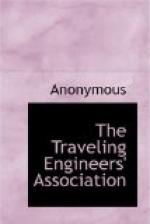[Illustration: Fig. 7. Diagram of B-6 Feed Valve, Open.]
Main reservoir pressure then forces the supply piston and valve over into open position, as shown in Fig. 7, and allows a further flow of air through port “c” to the feed valve pipe to again raise its pressure to the adjustment of the feed valve, when the valve will again close.
102. Q. What is the duty of the feed valve?
A. To control and maintain a constant pressure in the brake pipe when the brake valve is in running or holding position.
103. Q. What defect in the feed valve will cause the brake pipe pressure to equalize with that in the main reservoir?
A. This may be caused by a defective feed valve case gasket, permitting main reservoir air to leak into the feed valve pipe, or leakage past the supply valve, or the regulating valve held from its seat, or the supply valve piston too tight a fit in its cylinder.
104. Q. If the brake pipe charges too slowly when nearing the maximum pressure, where is the trouble?
A. This may be caused by a loose-fitting supply valve piston 8, or the port past the regulating valve 12 partly stopped up.
105. Q. How should the feed valve be tested?
A. With the brakes released, and charged to the adjustment of the feed valve, create a brake pipe leak of from seven to ten pounds and note the black hand on the brake pipe gauge. The fluctuation of this hand will indicate the opening and closing of the feed valve, which should not permit a variation of over two pounds in brake pipe pressure; if it does, it indicates a dirty condition of the valve, and should be cleaned.
106. Q. If the main reservoir pipe connection to the feed valve breaks, what should be done?




